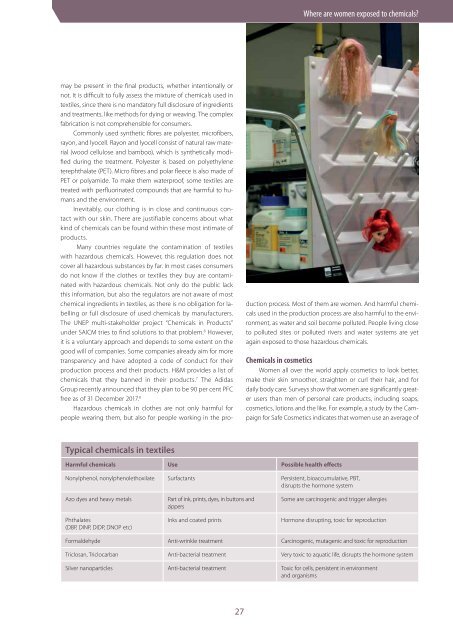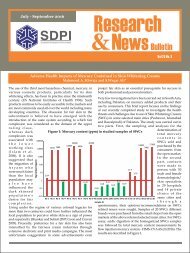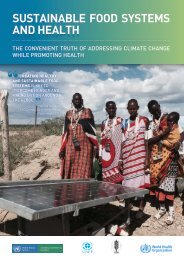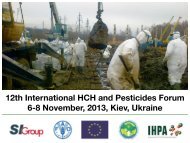Women and Chemicals
WomenAndChemicals_PublicationIWD2016
WomenAndChemicals_PublicationIWD2016
Create successful ePaper yourself
Turn your PDF publications into a flip-book with our unique Google optimized e-Paper software.
Where are women exposed to chemicals?<br />
may be present in the final products, whether intentionally or<br />
not. It is difficult to fully assess the mixture of chemicals used in<br />
textiles, since there is no m<strong>and</strong>atory full disclosure of ingredients<br />
<strong>and</strong> treatments, like methods for dying or weaving. The complex<br />
fabrication is not comprehensible for consumers.<br />
Commonly used synthetic fibres are polyester, microfibers,<br />
rayon, <strong>and</strong> lyocell. Rayon <strong>and</strong> lyocell consist of natural raw material<br />
(wood cellulose <strong>and</strong> bamboo), which is synthetically modified<br />
during the treatment. Polyester is based on polyethylene<br />
terephthalate (PET). Micro fibres <strong>and</strong> polar fleece is also made of<br />
PET or polyamide. To make them waterproof, some textiles are<br />
treated with perfluorinated compounds that are harmful to humans<br />
<strong>and</strong> the environment.<br />
Inevitably, our clothing is in close <strong>and</strong> continuous contact<br />
with our skin. There are justifiable concerns about what<br />
kind of chemicals can be found within these most intimate of<br />
products.<br />
Many countries regulate the contamination of textiles<br />
with hazardous chemicals. However, this regulation does not<br />
cover all hazardous substances by far. In most cases consumers<br />
do not know if the clothes or textiles they buy are contaminated<br />
with hazardous chemicals. Not only do the public lack<br />
this information, but also the regulators are not aware of most<br />
chemical ingredients in textiles, as there is no obligation for labelling<br />
or full disclosure of used chemicals by manufacturers.<br />
The UNEP multi-stakeholder project “<strong>Chemicals</strong> in Products”<br />
under SAICM tries to find solutions to that problem. 6 However,<br />
it is a voluntary approach <strong>and</strong> depends to some extent on the<br />
good will of companies. Some companies already aim for more<br />
transparency <strong>and</strong> have adopted a code of conduct for their<br />
production process <strong>and</strong> their products. H&M provides a list of<br />
chemicals that they banned in their products. 7 The Adidas<br />
Group recently announced that they plan to be 90 per cent PFC<br />
free as of 31 December 2017. 8<br />
Hazardous chemicals in clothes are not only harmful for<br />
people wearing them, but also for people working in the pro-<br />
duction process. Most of them are women. And harmful chemicals<br />
used in the production process are also harmful to the environment,<br />
as water <strong>and</strong> soil become polluted. People living close<br />
to polluted sites or polluted rivers <strong>and</strong> water systems are yet<br />
again exposed to those hazardous chemicals.<br />
<strong>Chemicals</strong> in cosmetics<br />
<strong>Women</strong> all over the world apply cosmetics to look better,<br />
make their skin smoother, straighten or curl their hair, <strong>and</strong> for<br />
daily body care. Surveys show that women are significantly greater<br />
users than men of personal care products, including soaps,<br />
cosmetics, lotions <strong>and</strong> the like. For example, a study by the Campaign<br />
for Safe Cosmetics indicates that women use an average of<br />
Typical chemicals in textiles<br />
Harmful chemicals Use Possible health effects<br />
Nonylphenol, nonylphenolethoxilate Surfactants Persistent, bioaccumulative, PBT,<br />
disrupts the hormone system<br />
Azo dyes <strong>and</strong> heavy metals<br />
Phthalates<br />
(DBP, DINP, DIDP, DNOP etc)<br />
Part of ink, prints, dyes, in buttons <strong>and</strong><br />
zippers<br />
Inks <strong>and</strong> coated prints<br />
Some are carcinogenic <strong>and</strong> trigger allergies<br />
Hormone disrupting, toxic for reproduction<br />
Formaldehyde Anti-wrinkle treatment Carcinogenic, mutagenic <strong>and</strong> toxic for reproduction<br />
Triclosan, Triclocarban Anti-bacterial treatment Very toxic to aquatic life, disrupts the hormone system<br />
Silver nanoparticles Anti-bacterial treatment Toxic for cells, persistent in environment<br />
<strong>and</strong> organisms<br />
27







